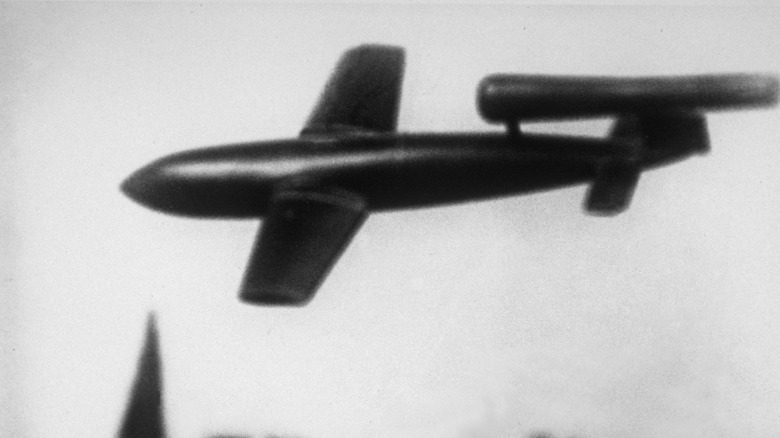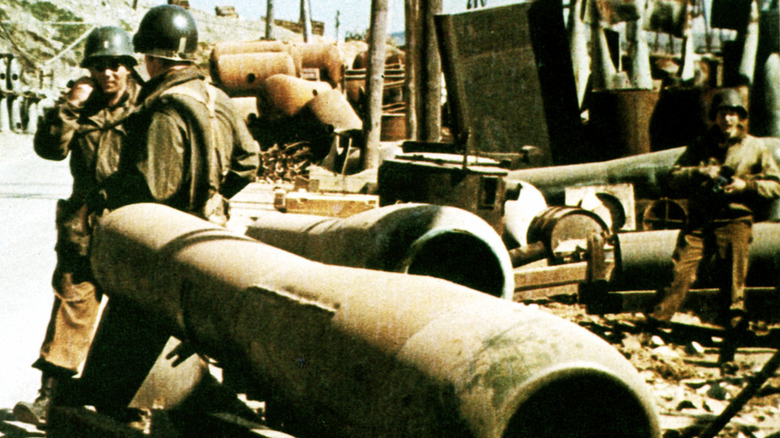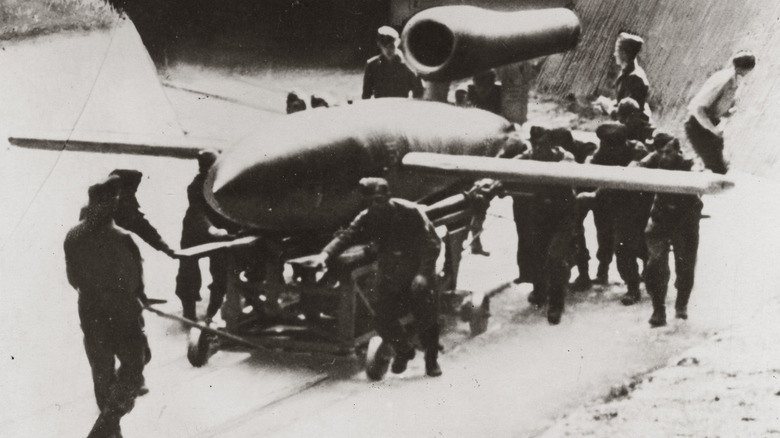Why German WW2 Missiles Were So Terrifying To Anyone Who Heard Them
Few World War II topics are as thoroughly researched and hotly debated as Germany. German technological developments were as infamous as they were (generally) effective, thanks in no small part to the regime in control. One of the hallmarks of Hitler and his politics was the employment of psychological warfare, ruthlessly carried out by his followers to profound effect. From propaganda films and posters saturating the media to the near-thorough scrubbing of vast libraries of cultural knowledge, they were skilled in crafting a certain image in German hearts as well as in sowing fear in the minds of the nation's enemies.
One often-overlooked method by which they spread fear particularly efficiently was the use of sound as a weapon. Not in the sense of immobilizing people with deafening sound, but by using devices with elements that produced a distinct sound as a psychological weapon. These included (but aren't limited to): whistles fitted on bombs; the Jericho trumpet or "Stuka Siren" that gave the Junkers Ju-87 dive bomber an iconic terrifying scream; and the distinctive crackling of a pulsejet-powered flying bomb — the V-1. Here's what the V-1 sounded like and why, as well as its psychological and physical impact on the war during its one-year service life.
The Vengeance Weapon program
World War II Germany used a diverse (and sometimes dominating) array of aircraft and early rocket technology, some of which was pioneering, though many were far too quirky, suicidally volatile, unreliable (or all three). But one development proved respectably effective. Codenamed "V-1" ("Vergeltungswaffe Eins," or "Vengeance Weapon-1,") it was the world's first operational cruise missile, deployed against Allied targets in London; Antwerp, Belgium; and other cities from June 1944 to March 1945.
In total, approximately 2,400 V-1s reached their destinations. Their pulsejet engines produced a highly distinctive noise due to the way they functioned, earning them the nicknames "buzz bomb" and "doodlebug." The V-1 was responsible for thousands of casualties and became one of the war's most fear-inducing weapons – no small feat in a conflict featuring flamethrower tanks, indiscriminate bombing, and horrifying war crimes.
The sound the V-1 produced was due to its intermittent combustion, which means that unlike a traditional jet engine with one long, continuous burn, a pulsejet does just that — it pulses. It's an incredibly simple, elegant design; thrust is generated like waves by use of a spring-loaded butterfly valve that closes with the force of each explosion, cutting off fuel in a controlled manner to create a specific pulse frequency. These pulses generate exhaust, which provides the thrust. Secondarily, however, they also created that unique sound – if you're wondering what an original Argus 109-104 sounds like, here's a YouTube video showcasing the engine starting up.
Sound as a psychological weapon
Using sound to create emotional states is well-understood today, with specialized sound therapy in widespread use. We know that certain sound frequencies are particularly pleasing, such as the roar of a classic F1 car's V-10 engine, while other notes, such as those heard when a baby is crying, produce anxiety and anger. The one we're concerned about here is a lower-frequency growling sound, like the one produced by the pulsejet. Unlike a normal engine, the Argus produces a low frequency in which one can hear a separation of each pulse, like a gun firing or a predator's growl. This type of sound is known to trigger an unsettling feeling in both animals and humans.
Another psychological tool at work here is the unexpected, sudden nature of the sound. This isn't the sound we think of when we picture old fighter aircraft or bombers. It's unlike any other sound people living in mid-1940s England had likely ever heard, including Stuka trumpets, air-raid sirens, and bomb whistles; all of them are higher-frequency notes. A pulsejet created horror through this distinction. It was loud, immediately identifiable, and virtually unknown. Entire genres of horror fiction have been created to exploit humanity's innate fear of the misunderstood and unknown, further cementing the V-1's legacy as a terror weapon.


